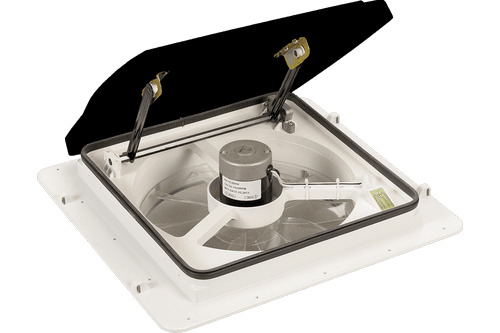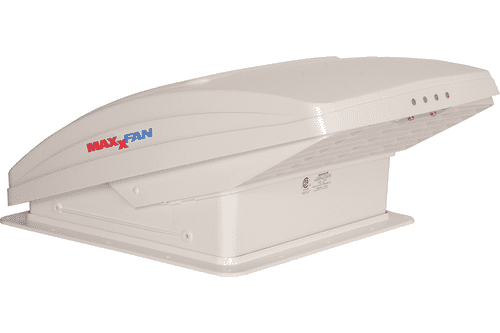Van Life Airflow 101: Why a Roof Fan Vent is a Must-Have

Breezing Through Van Life: The Key Role of Ventilation
In the adventurous world of van life, where the call of the open road and the lure of unseen horizons define existence, the home-on-wheels becomes more than just a mode of transport—it becomes a sanctuary. Whether you’re parked by the turquoise splashes of a coastal beach, nestled within the whispered secrets of a dense forest, or under the timeless gaze of mountain peaks, your van isn’t just a vehicle, it’s your lifeline.
Despite the glamorous appeal that #vanlife pictures on social media may portray, living in a van requires meticulous planning and smart living strategies. One aspect that’s often overlooked, yet crucial to comfortable and healthy living within this compact space, is ventilation.
Proper ventilation is the unsung hero of van life. It’s vital for maintaining good air quality, reducing condensation (which can lead to mold), and controlling temperature within the van. Check out this blog post about controlling humidity HERE. Regardless of whether it’s a frosty winter night or a scorching summer day, effective ventilation ensures that the van’s interior remains as comfortable as possible. For those sharing this small space with pets or partners, or those who cook inside the van, ventilation is indispensable.
A well-ventilated van is more than just a comfortable living space; it’s a safer and healthier one. Now, as we cruise further down the highway of van living, we’ll uncover why the roof vent, an often underestimated device, deserves a standing ovation. Buckle up, for we’re about to embark on a ventilation adventure in the realm of van life!
Unlocking Comfort: The Perks of a Rooftop Fan Vent
Living in a van exposes individuals to fluctuating temperatures, from scorching summer heat to chilly winter nights. Without proper ventilation, the interior of a van can quickly become uncomfortable and stuffy, making it difficult to relax or sleep. Inadequate airflow can lead to the accumulation of moisture, resulting in condensation, mold growth, and an overall decline in air quality.
Living in a van comes with exposure to changing temperatures, ranging from scorching summer days to chilly winter nights. If the van lacks proper ventilation, the interior can quickly become uncomfortable and stuffy, hindering relaxation or sleep. The absence of adequate airflow can also allow moisture to accumulate, leading to condensation, mold growth, and a drop in air quality.
Venting the Heat: A Cool Solution
Proper ventilation is a critical tool for dealing with extreme heat inside your home on wheels. When the sun warms up the van, the metal body absorbs the heat, causing the inside temperature to rise. A roof vent can help by drawing this hot air out and pushing it outside. This process can reduce the interior temperature significantly, making the van’s environment more comfortable.
Being on the road full-time doesn’t mean leaving your furry friends behind. Many van lifers and RV dwellers choose to bring their pets along for the ride, turning their journey into a shared adventure. However, ensuring the comfort and safety of pets in a vehicle can indeed be a major source of stress.
Pets, much like humans, are susceptible to fluctuating temperatures and poor air quality. With their fur coats, animals can quickly overheat in a van that’s baking in the sun, leading to serious health risks. On the other hand, during colder months, a lack of proper heating can lead to discomfort for your pets. I often feel like the summer months are more challenging because it’s easier to keep my dogs warm than it is to keep them cool.
This is where a proper vent becomes an essential tool. The constant circulation of air provided by the vent helps maintain a more stable and comfortable temperature within the vehicle, reducing the risk of overheating during hot periods. In colder months, it can help maintain a drier environment, reducing damp and cold spots.
Even when you have to leave your pets briefly in the van, proper ventilation can provide peace of mind. By keeping the air circulating, it can help ensure that your pet is comfortable until you return. Remember, though, that safety precautions should always be taken when leaving pets unattended in a vehicle, especially in extreme weather conditions. You should also be aware that it is against the law in some areas to leave a pet unattended.
Having a pet-friendly setup in your van or RV involves planning and care, and ventilation plays a vital role in this setup. It’s not just about human comfort; it’s about ensuring that your entire road family, including the four-legged members, can enjoy the journey safely and comfortably.
Winning the Winter War: Combating Condensation and Cold
During colder months, a proper vent is just as useful. Activities such as cooking and breathing release moisture into the air. When this warm, moist air hits cold surfaces, like windows or metal walls, it condenses into water droplets. Over time, this condensation can promote mold growth, which could harm both your van and your health. Proper ventilation can prevent this by continuously replacing the moist interior atmosphere with dry outside fresh oxygen, reducing the overall humidity inside the van.
When this warm, moist air contacts colder surfaces such as windows or metal walls, it condenses into water droplets. This phenomenon, known as condensation, may seem innocuous at first, but over time, it can create a host of problems.
A buildup of condensation can lead to damp surfaces, making the van feel colder and increasing the need for heating. Damp conditions can also damage the van’s interior, including upholstery, electronics, and wooden structures.
But perhaps the most worrying outcome of unchecked condensation is mold growth. These fungi thrive in moist conditions and can proliferate rapidly once established. Exposure to mold can lead to a variety of health issues, including allergies, respiratory problems, and in severe cases, more serious illnesses.
Proper ventilation comes to the rescue by continually cycling the air inside the van. By drawing in drier, cooler outside air and expelling warm, humid interior air, it helps reduce the overall humidity level inside the van. This constant airflow prevents condensation from forming, protecting your van’s interior and your health.
Additionally, many these devices come with features like thermostat control or rain sensors. Thermostat control allows the fan to kick in when the temperature inside the van reaches a certain point, ensuring a comfortable environment. Rain sensors, on the other hand, automatically close the cover when they detect rain, preventing water from entering the van.
In the battle against the cold and condensation, proper ventilation serves as a crucial ally. By promoting efficient oxygen exchange, it helps create a healthier, more comfortable, and ultimately more enjoyable van living experience during the chillier months. Remember, a little bit of prevention can save a lot of headaches and repair bills down the line.
A Fresh Breath: Maintaining Air Quality
Air quality inside a van can degrade rapidly without proper ventilation. Cooking smells, pet odours, or carbon dioxide exhaled by occupants can contribute to a stuffy, unpleasant atmosphere. A roof vent can expel stale, odorous air and draw in fresh air from outside. This continuous air circulation can help maintain a healthier and more enjoyable living environment.
Investing in proper ventilation can help tackle these challenges, making your van a more comfortable, healthier place to live. It’s not just a piece of equipment; it’s a vital component in creating a livable home on wheels.
Selecting Your Air Ally: Key Features to Consider in a Roof Fan Vent
When it comes to choosing the right device for your van, not all options are created equal. Various models come with different features and specifications, each suited to particular needs and preferences. While it’s easy to get caught up in the technicalities, the key is to focus on the features that directly impact your comfort and convenience. Let’s explore some of the critical factors you should consider.
Size Matters: Matching Vent to Vehicle
The size of the device you choose can significantly influence its effectiveness. Larger units usually provide better airflow, but they also require more roof space for installation. Smaller units, on the other hand, might be more suitable for compact vans or situations where roof real estate is limited. I’m a firm believer in roof vent covers. I spend most of my time in Beatiful but damp British Columbia. You can easily get up to a rainy morning that turns into a sunny hot afternoon.
Power Up: Solar or Battery?
Another essential factor to consider is the power source. Typically these devices run on a 12 volt battery. I had a really hard time finding any that were self contained with their own solar source and battery. Hey want to make a million dollar invention???
Keeping my van cool(check out our related blog post about magnetic bug screens to help air flow) in the summer was the major reason I had solar panels installed in my van. Without solar to keep my battery charged I didn’t trust that I could run my sprinter roof fan all day in the hot summer months. It wasn’t cheap, you can read more about choosing a solar system HERE.
Pace Yourself: Speed Settings
Most of these devices come with multiple speed settings, allowing you to control the rate of air exchange based on your current needs. Higher speed settings provide more rapid circulation, useful for quickly cooling a hot van or removing strong odors. On the other hand, lower speed settings can be used for maintaining a comfortable temperature or gentle air exchange during sleep.
Some devices have different temperature settings to help you maintain the internal temp in your home on wheels. You can set it to turn on or off once the desired temperature is reached.
Noise Levels: Peaceful Slumbers
The noise level of the unit is a crucial consideration, particularly for those who value peace and quiet. While most typical units operate relatively quietly, it’s worth checking customer reviews to ensure the noise level is acceptable for you. I tend to be a really light sleeper and having the background of a fan running all night helps me sleep.
Installation Ease: DIY or Professional Help?
Finally, the ease of installation can be an important factor, especially for DIY van builders. Some devices are more user-friendly in their installation requirements, while others may necessitate professional help. Evaluate your comfort level with DIY projects and consider potential installation costs when choosing. I know the thought of cutting into your rig can be a major source of anxiety. There isn’t much worse than having a leak, but with proper installation and sealing it’s possible to do this job properly on your own.
Ventilation Victories: Unveiling the Best Roof Fan Vents
Ventilation is an essential aspect of van life, but choosing the right ventilation system can be a daunting task with so many options available. To help streamline the process, we’ve rounded up some of the top roof fan vents in the market, each offering unique features to cater to your specific needs. From energy efficiency to quiet operation, these ventilation systems stand out for their outstanding performance, user-friendly features, and rave reviews from satisfied van lifers.
- Built-In rain cover provides full time protection, while fan is on or off
- Use the fan while it’s raining or when driving
- Powerful 10 speed reversible fan with thermostat to control room temperature
- Optional remote control with programmable thermostat
- Easy to remove interior insect screen, no tools required
- Fits all standard 14″x14″ roof openings
- Features a powerful, fuse protected, long life, sealed ball bearing, 12-volt fan motor and a 12 inch, 10 blade fan
- 2-year limited warranty with lifetime limited warranty on the lid
- Roughly $245 at time of posting

- Three fan blade speeds
- Intake and Exhaust
- 10 SPEED REMOTE CONTROL: Closes the lid and shuts off the fan when it gets wet. Powered-lift lid opens and closes automatically.
- Quiet operation won’t disturb you
- Fits standard 14 in. x 14 in.
- High profile base
- Roughly $170 at time of posting

- High powered 10-speed intake and exhaust fan
- remote control
- Waterproof, molded mounting tabs for TOOL FREE installation of the FANMATE Vent Cover (Sold Separately)
- Manual Opening or Remote Control Electric Opening models available
- Rain Sensor closes lid if it rains (4500K)
- White or Smoke Tint lid available
- roughly $260 at time of posting
The Whirlwind Wizard: Understanding How a Vented Rooftop Fan Works
A roof fan for van life seems like a straightforward device, but the science behind its operation is quite amazing. It plays a dual role in managing the airflow inside your van, serving as both an exhaust fan and an intake vent. By understanding its mechanics, you can utilize it more effectively to maintain a comfortable living environment inside your van.
Exhaust Function: Expelling the Old
When set to exhaust mode, the device operates much like any other fan. The blades spin, creating a flow of air that moves from the inside of your van to the outside environment. This process is crucial for expelling warm, stale, or odorous air from your van’s interior.
The exhaust function becomes particularly valuable during hot weather or after activities like cooking. By removing warm air, the fan helps lower the interior temperature, making the van more comfortable. Likewise, any lingering smells from cooking or pets can be quickly and efficiently removed, helping maintain a pleasant atmosphere inside your van.
The exhaust function is your best friend when it comes to helping control humidity in your tiny home on wheels. Showering, cooking, breathing, all these things create humidity in an enclosed space.
Intake Function: Welcoming the New
On the flip side, it also has an intake function. In this mode, the direction of the blades is reversed, drawing fresh oxygen from the outside into your van. This influx of freshness is essential for several reasons.
Firstly, the incoming air helps replenish the oxygen levels inside the van, providing a healthier environment, especially during sleep. Secondly, when the incoming fresh air mixes with the warm air inside the van, it aids in regulating the temperature, making the interior more comfortable.
Then, on cool nights, the intake function can be used to draw in the refreshing, cool air, helping to maintain a comfortable sleeping environment without the need for conventional power draining A/C use.
A Dance of Dual Functions
Together, the exhaust and intake functions of the unit enable a continuous exchange of air, creating a dynamic airflow system within your van. This balance of pushing out old, stale oxygen and pulling in fresh, new oxygen is what keeps the atmosphere in your van comfortable and healthy, regardless of the conditions outside.
It’s worth noting that for optimal performance, it helps to have another vent or window slightly open while operating the roof fan. This allows for more efficient exchange and prevents a vacuum from being created inside the van.
Empowering Your Van: A Step-by-Step Guide to Installing a Fan Vent
While installing anything can be a somewhat involved process, it can be tackled as a DIY project if you’re comfortable with basic tools and have a certain level of handyman skills. Before we start, it’s important to note that while this guide provides a general outline of the installation process, you should always refer to the manufacturer’s instructions included with your specific device. Each model may have slight differences in installation requirements. For those less comfortable with DIY projects, hiring a professional may be the best route to ensure a safe and secure installation.
Tools Required
Before you begin, gather all necessary tools. Make sure to wear the appropriate personal protection equipment. Glove and safety glasses are a must. Watch at least 3 videos on YouTube! Start with this one. These might include:
- A jigsaw or reciprocating saw for cutting the hole in the van roof
- Screwdrivers
- Sealant for waterproofing the installation
- A drill for creating pilot holes
- Measuring tape and a marker
Step 1: Mark the Spot
First, you’ll need to decide on placement of your device. Once you’ve decided, use a marker and a straight edge to outline the exact size of the hole required for your specific roof vent model. It’s important to work around potential places for solar panels etc.
Step 2: Prep and Cut
Next, drill a pilot hole in one corner of your marked square to provide a starting point for your saw. Then, using a jigsaw or reciprocating saw, carefully cut along your marked lines.
Step 3: Prep the Vent
Now it’s time to prepare the vent for installation. Depending on your vent model, this may involve attaching any provided brackets or preparing the vent for sealing. Now is a good time to sort out wiring etc as well. I always recommend consulting a professional electrician for wiring.
Step 4: Install the Vent
Place the unit into the hole, making sure it fits snugly. Attach it according to the manufacturer’s instructions, usually by screwing it into place and following the wiring directions.
Step 5: Seal the Installation
The final step is to waterproof the installation. Apply a generous amount of sealant around the edges of the unit where it meets the roof. This will prevent any water leakage.
Testing and Troubleshooting
Once the device is securely installed, test it to ensure it’s operating correctly. Keep an eye out for any unusual noises or vibrations. If you encounter any issues, refer to the manufacturer’s troubleshooting guide, or consider consulting a professional.
By following these steps, you can add a powerful tool to your van that helps manage ventilation and temperature, making your mobile living space that much more comfortable and enjoyable. But remember, if any part of this process feels overwhelming or beyond your skill level, don’t hesitate to enlist professional help. A well-installed rooftop vent is a long-term investment in your comfort and health on the road.
Breeze Keeper: Maintaining and Troubleshooting Your Roof Fan
While roof fan vents are generally robust and reliable, like any device, they require regular maintenance to ensure they continue to function optimally. By following a few simple maintenance tips, you can keep your unit operating efficiently and prolong its lifespan. Having some basic troubleshooting knowledge can help you address common issues that might arise, saving you time and potential repair costs.
Regular Cleaning
One of the most straightforward maintenance tasks is regular cleaning. Dust and dirt can build up over time, affecting the fan’s performance and potentially causing undue wear on the motor. At least once every few months, remove the cover and clean the fan blades and the vent area with a damp cloth. Avoid using harsh or abrasive cleaners, which can cause damage.
Lubrication
Another easy but effective maintenance tip is to lubricate the fan motor occasionally. This helps keep it running smoothly and reduces the risk of overheating or mechanical failure. Use a small amount of a light machine oil or a product specifically designed for fan motors. Be sure to consult your manual for any specific lubrication instructions or recommendations.
Inspect Seals
Inspect the seal regularly to ensure it remains watertight. Over time, exposure to the elements can cause the sealant to degrade. If you notice any cracks or gaps, reapply a suitable sealant to prevent potential water leakage.
Troubleshooting Tips
Despite regular maintenance, you might encounter occasional issues with your roof fan. Here are solutions to some common problems:
Fan Not Operating: If your fan isn’t turning on, check the power source. Make sure it is correctly connected to the battery, and the battery has sufficient charge. If you have a solar-powered 12volt system, check the solar panels for any dirt or debris that could be blocking sunlight.
Unusual Noises: If your fan is making unusual noises, it might be due to dust or debris caught in the blades. Remove the cover and clean the blades. If the noise continues, the issue might be with the motor, which may need to be replaced.
Reduced Airflow: If you notice a decrease in airflow, check for any obstructions in the vent or the fan blades. Also, inspect the cover to ensure it’s fully opening.
Know When to Call in the Pros
While these troubleshooting tips can resolve many common issues, don’t hesitate to consult a professional if you’re unsure about any aspect of maintenance or repair. Some problems, especially those related to the motor or electrical connections, should be handled by a professional to avoid injury or further damage.
By regularly maintaining and swiftly addressing any issues, you’ll ensure that it continues to serve its crucial role in your van life journey, providing freshness comfortable temperatures wherever your road takes you.
Venturing Ahead: Making Rooftop Fan Ventilation Your Trusted Companion
The journey through van life is as unpredictable as it is thrilling. Every bend in the road brings new landscapes, new adventures, and new challenges. One of the most persistent challenges van dwellers face is maintaining a comfortable, healthy living environment within their compact mobile home. That’s where a roof vent comes into play.
From efficiently managing the temperature within the van during sweltering summers and cold winters, to ensuring a healthy indoor atmosphere by reducing humidity and maintaining air quality, a roof fan vent stands as an unsung hero in the realm of van life. And with options to suit various power sources, sizes, noise levels, and ease of installation, there’s a model out there that’s the right fit for every van and every lifestyle.
Whether you’re cooking up a storm, embarking on a workout, or simply curled up with a good book, the subtle whisper of the roof fan vent will be there, working tirelessly to make your van a healthier, safer, and more comfortable place to live.
So, as you continue your journey down the endless highway of van life, consider making a roof fan vent your trusted companion. It’s more than just a piece of equipment; it’s an investment in your comfort and wellbeing, a symbol of your commitment to living life on the road to its fullest.
Let the open road beckon, let the adventures unfold, and let your roof fan vent take care of the breeze. Happy venturing!








